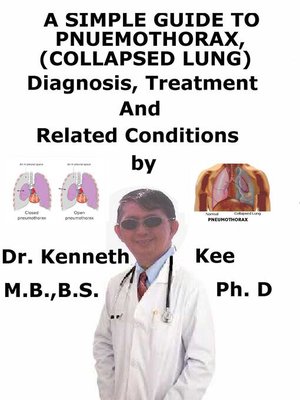A Simple Guide to Pneumothorax (Collapsed Lungs), Diagnosis, Treatment and Related Conditions
ebook
By Kenneth Kee

Sign up to save your library
With an OverDrive account, you can save your favorite libraries for at-a-glance information about availability. Find out more about OverDrive accounts.
Find this title in Libby, the library reading app by OverDrive.



Search for a digital library with this title
Title found at these libraries:
| Library Name | Distance |
|---|---|
| Loading... |
This book describes Pneumothorax (Collapsed Lungs), Diagnosis and Treatment and Related Diseases
A collapsed lung (pneumothorax) happens when air escapes from the lung.
The air then fills the pleural space outside of the lung between the lung and chest wall.
This air pushes on the outside of the lung and makes it collapse.
This buildup of air places pressure on the lung, so it cannot expand as much as it normally does when the patient takes a breath.
A pneumothorax can be a total lung collapse or a collapse of only a section of the lung.
Causes
Chest injury
Collapsed lung (pneumothorax) can be produced by an injury to the lung.
Trauma or injuries to the chest can produce a gunshot or knife wound to the chest, rib fracture, or certain medical and surgical procedures.
Any blunt or penetrating injury to the chest can induce lung collapse.
Some injuries may happen during physical assaults or car accidents, while others may inadvertently happen during medical procedures that involve the insertion of a needle into the chest.
In some patients, a collapsed lung is produced by air blisters (blebs) that break open, allowing air to escape into the space around the lung.
This can happen from air pressure alterations when scuba diving or traveling to a high altitude.
Tall, thin people and smokers are normally more at risk for a collapsed lung.
Lung disease
Injured lung tissue is more likely to collapse.
Lung damage can be produced by many types of underlying diseases, such as:
1. Chronic obstructive pulmonary disease (COPD),
2. Cystic fibrosis,
3. Lung cancer or
4. Pneumonia.
Cystic lung diseases, such as lymphangioleiomyomatosis and Birt-Hogg-Dube syndrome, produce round, thin-walled air sacs in the lung tissue that can burst, resulting in pneumothorax.
Lung diseases can also raise the chance of getting a collapsed lung.
1. Asthma
2. Chronic obstructive pulmonary disease (COPD)
3. Cystic fibrosis
4. Tuberculosis
5. Whooping cough
Ruptured air blisters
Small air blisters (blebs) can form on the top of the lungs.
These air blisters occasionally rupture permitting air to leak into the space that surrounds the lungs.
Mechanical ventilation
A severe type of pneumothorax can happen in people who need mechanical assistance to breathe.
The ventilator can generate an imbalance of air pressure within the chest.
The lung may collapse totally.
In some cases, a collapsed lung happens without any cause (spontaneous).
The primary symptoms of a pneumothorax are:
1. Sudden onset of chest pain and
2. Shortness of breath.
If the patient has a collapsed lung, there are reduced breath sounds or no breath sounds on the affected side.
Tests that may be ordered are:
1. Arterial blood gases and other blood tests to assess oxygen levels
2. Chest x-ray to diagnose the pneumothorax
3. CT scan if other injuries or disorders are suspected
4. Ultrasound imaging also may be used to identify a pneumothorax.
5. Electrocardiogram (ECG)
The purpose in treating a pneumothorax is to relieve the pressure on the lung, permitting it to re-expand.
Depending on the cause of the pneumothorax, a second purpose may be to prevent recurrences.
The patient may be given supplemental oxygen therapy to speed air reabsorption and lung expansion.
Treatment methods may involve:
1. Observation,
2. Needle aspiration,
3. Chest tube insertion,
4. Non-surgical repair or
5. Surgery.
TABLE OF CONTENT
Introduction
Chapter 1...







